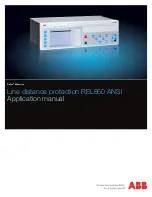
3 • Introduction
________________________________________________________________________________________________
2.
INTRODUCTION
The TPR-6, Temperature Protection Relay is a new generation of micro-processor based relay, designed to
protect electric motors, transformers and other systems from over temperature.
The TPR-6 has 6 or 14 temperature inputs that can be programmed to measure Thermistors (PTC or
NTC) and RTDs (Pt100).
Each temperature input can be Disabled or Enabled, designated as Thermistor-PTC or Thermistor-NTC or
RTD (Pt100). Protection levels and time delay are programmable as well as grouping for combining the
data in the analogue output.
Temperature sensors types & mode of operation.
Number of sensors - can be set from 1-6 or 1-14
Sensor type
– Each sensor can be set as RTD, Thermistor-PTC, Thermistor-NTC or Not Used
(requires changing sensor type from RTD to Thermistor and Vice Versa and includes internal dip
switches modification – refer to page 18 for dip switches settings).
Level 1
(for example Alarm) – Different levels can be set for each sensor. Levels are set in degrees
C for RTD type sensors or KΏ for Thermistor type sensors.
Level 2
(for example Trip) - Different levels can be set for each sensor. Levels are set in degrees C
for RTD type sensors or KΏ for Thermistor type sensors.
Time delay level 1
–
A time delay can be set for level 1.
Time delay level 2 -
A time delay can be set for level 2.
Group of sensors
–
Used for analogue output.
Input / Output configuration
Unique Tripping / Alarm options makes it possible to designate any fault as an Alarm, Trip, both or none.
This unique facility also enables controlled fault Reset possibilities.
Alarm relay
as Alarm, Alarm-fail safe or Tripping / Alarm.
Trip relay
as Trip, Trip-fail safe or Tripping / Alarm.
Input 1
(discrete) – As Remote Reset, External Fault 1 – N.O. or N.C. contact
Input 2
(discrete) – As Remote Reset, External Fault 2 – N.O. or N.C. contact
Analogue output
–
As 0-20mA Normal or 4-20mA Normal or Inverted
Analogue output group
– Group Minimum, Average, Maximum
Communication RS485
– can be locked or unlocked, address numbers for each sensor and baud
rate.
Trip / Alarm configuration
Each sensor as well as two discrete inputs, communication fault and internal fault can be configured,
separately for level 1 and 2, as follows:
Trip function
– Enabled or Disabled
Alarm function
– Enabled or Disabled
Auto Reset function
– Enabled or Disabled
Operating Relay A
– Enabled or Disabled
Operating Relay B
– Enabled or Disabled
Operating Relay C
– Enabled or Disabled
Operating Relay D
– Enabled or Disabled
Displaying Actual data
Temperature (RTD) or resistance (Thermistors) of each sensor, Failure of sensor connecting wires.
































